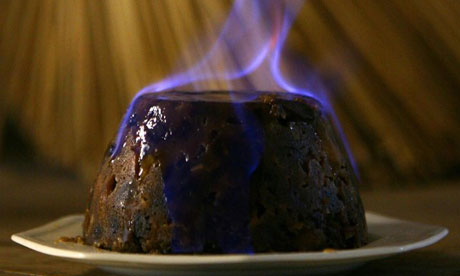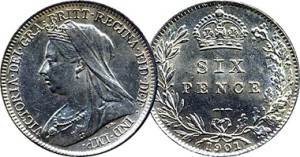A Scion Society of The Baker Street Irregulars

A Victorian Recipe for Christmas “Pud”
 With Christmas approaching, let us examine a recipe for traditional Christmas Pudding. I say “traditional,” because this particular item has been concocted by my family for over 100 years, having been brought to the colonies by my late Grandmother (born Chapwick, Somerset, in 1883). It was her Mother’s recipe. From my earliest recollections, I can remember the “pud” being brought to the table, flaming, on a silver tray… and then having it shoved down my throat, like it or not! But I did come to like the stuff, even after I found out what is really in it. It is best prepared WELL in advance; traditionally, it is prepared on “Stir Up Sunday,” the Sunday before Advent…. so called because the Collect for that day, in the Anglican Church, reads: “Stir up, we beseech the, O Lord, the wills of Thy fruitful people….”. For guaranteed good luck in the coming year, everyone in the family takes a turn at stirring the pot. And this stuff really keeps! What with the exigencies of daily life, we usually make a 3 year supply at one time.
With Christmas approaching, let us examine a recipe for traditional Christmas Pudding. I say “traditional,” because this particular item has been concocted by my family for over 100 years, having been brought to the colonies by my late Grandmother (born Chapwick, Somerset, in 1883). It was her Mother’s recipe. From my earliest recollections, I can remember the “pud” being brought to the table, flaming, on a silver tray… and then having it shoved down my throat, like it or not! But I did come to like the stuff, even after I found out what is really in it. It is best prepared WELL in advance; traditionally, it is prepared on “Stir Up Sunday,” the Sunday before Advent…. so called because the Collect for that day, in the Anglican Church, reads: “Stir up, we beseech the, O Lord, the wills of Thy fruitful people….”. For guaranteed good luck in the coming year, everyone in the family takes a turn at stirring the pot. And this stuff really keeps! What with the exigencies of daily life, we usually make a 3 year supply at one time.
Should you wish to try this item of Victorian delight, here is how one goes about it. The ingredients are as follows:
- 1 cup suet (see your butcher; don’t ask what it is!)
- 1 ¼ cups each of flour and breadcrumbs
- 1 cup dark brown sugar
- ½ teaspoon of baking powder
- 1 cup, total, of combined candied lemons, oranges and citron peel, in about equal proportions
- 2 ½ cups seeded Muscat raisins
- 1 ½ cups currants
- ½ teaspoon ground cloves
- 3/8 teaspoon, EACH, of nutmeg, allspice and cinnamon
- 1 ¼ cup (approximately) of liquid consisting of 1 egg (beaten), Port wine, orange juice & lemon juice… maybe a dash of Cognac
Begin by fine-chopping or grating the suet. Forget the food processor, it will only make a slimy mess. VERY thoroughly combine all of the ingredients; it may take you good half hour to get everything mixed! When I was little, I was told that it was good luck for everyone in the house to take a turn at stirring the thing. It is easier to mix concrete! Once everything is thoroughly mixed, pack it into a well buttered heatproof ceramic bowl (or pudding steamer). Cover the top with a piece of buttered wax paper. Cover with a large, white linen, cloth. Tie down the cloth with string, just below the rim of the bowl, leaving the cloth just a little loose on top to allow for expansion. Bring the 4 corners of the cloth to the top and tie in knots. Drop into BOILING water and cook for 3 hours. KEEP THE WATER BOILING AT ALL TIMES. When you must add more water, add BOILING WATER (means that you must have a second pot boiling at all times). Important: do not submerge the entire bowl! Maintain the level of boiling water about 1 inch below the top of the bowl. Using the corners of the cloth as a handle, remove bowl from the boiling water (wear hot mitts!) and tilt the bowl to drain off all water from the cloth, until it is dry. You may pour a bit of Cognac on the cloth, every month or so. Store in a cool place.
Then, on the Festive Night, reheat it in the same way, for 3 hours. Now remove the string and cloth. Before popping the pud out of its bowl, you may wish to insert one or more coins (well cleaned and shined) into the base of the pud, along the edge. Should be served HOT!
Invert the bowl onto a heat and fire proof serving platter. We use a silver tray. Place 2 or 3 sugar cubes on top, in the center; pour 2 or 3 ounces of pre-warmed Cognac on the cubes (I cheat a bit and use some 151 proof Rum as well, to assure a good flame). Ignite the thing and carry it in a triumphant presentation to the guests and family who seated at the table (the lights having been turned off for the presentation). The alcohol flame is not very bright but its HOT; watch out for it. Pray that you don’t trip over the damned dog and ignite the house! Inform all concerned that, should he or she be the one lucky enough to receive a coin, it must be saved… not spent until after NEXT Christmas! The penalty for spending it sooner is to cancel all of the good luck that it provides for the remainder of the year PLUS having 2 years of bad luck!!!
A variation of this recipe is that of a plum pudding… which is made of meat broth (usually beef), raisins, prunes, fruit juice, spices, wine – all thickened with brown breadcrumbs. This delicacy is served as an appetizer. But our traditional pudding was always as a dessert, served along with a cheese board (Stilton, Cheddar, double Gloucester, Camembert), some Port and sparkling Burgundy… and freshly baked cookies of various festive varieties.
Silver Charms
 The Victorian custom was to put only 1 silver sixpence in the pud, plus some of a dozen or so charms; the sixpence meant that the recipient would have good fortune, next year; the ring meant a forthcoming wedding; the baby was obvious; but woe unto her who got the thimble, for she would be an old maid (at least for the next year). The items inserted into the pud would be dictated by the type of dinner guests, i.e. males/females, married/unmarried, young or old.
The Victorian custom was to put only 1 silver sixpence in the pud, plus some of a dozen or so charms; the sixpence meant that the recipient would have good fortune, next year; the ring meant a forthcoming wedding; the baby was obvious; but woe unto her who got the thimble, for she would be an old maid (at least for the next year). The items inserted into the pud would be dictated by the type of dinner guests, i.e. males/females, married/unmarried, young or old.  You may still find them in specialty stores, or antique stores, in this country. Slightly more readily available, in the UK. My earliest recollections are of dimes, only, in the pud.
You may still find them in specialty stores, or antique stores, in this country. Slightly more readily available, in the UK. My earliest recollections are of dimes, only, in the pud.
Bon Appetit!
William Pavey Meskan, aka “Beau”, is the 12th Garrideb, invested as the Lord High Constable. In addition, he is a member of The Scotland Yarders, Col. Sebastian Moran’s Secret Gun Club, The Sherlockian by Invitation Only Society, The Detectives of Chicago Central, STUD Sherlockian Society, Hugo’s Companions and the Hounds of the Baskervilles. This article is copyrighted by him, © 2000.

[…] Sunday” was the day on which the Christmas Pud would be prepared, well in advance of Christmas! A plumb pudding, made with meat broth, raisins, […]